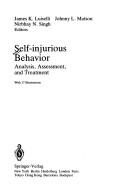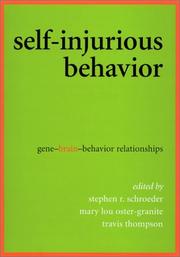| Listing 1 - 10 of 113 | << page >> |
Sort by
|
Book
ISBN: 2810910545 Year: 2022 Publisher: Rennes : Presses de l'EHESP,
Abstract | Keywords | Export | Availability | Bookmark
 Loading...
Loading...Choose an application
- Reference Manager
- EndNote
- RefWorks (Direct export to RefWorks)
La crise sanitaire a vu une forte augmentation des dépressions, troubles anxieux et gestes suicidaires chez les 15-24 ans, en particulier chez les filles. Enjeu majeur de santé publique, la prévention du suicide mobilise de nombreux acteurs qui prodiguent écoute et conseils et accompagnent les jeunes en souffrance en maintenant un lien bienveillant. Prolongeant les enseignements d'une enquête sociologique sur les parcours des jeunes suicidaires et suicidants, cet ouvrage analyse les besoins et « portes d'entrée » pour une prévention et une prise en charge coordonnées et efficaces, et souligne les difficultés des professionnels du soin et de la relation. Comment adapter les cadres et les dispositifs de suivi ? Dans quels contextes et par quels mécanismes les adultes sont-ils aidants ou au contraire se détournent-ils des jeunes ? Quel rôle jouent les réseaux sociaux dans l'expression et l'écoute des idées suicidaires ? Comment mieux détecter les signes de détresse par-delà les non-dits ? Les professionnels de la santé scolaire, du soin et du social, de l'administration de la santé, les associations de prévention et plus largement les familles trouveront ici, au fil de témoignages forts et rares de jeunes, des ressources pour décoder les comportements et les paroles, ainsi qu'une certitude : être écouté sans être jugé et parler de sa souffrance est une étape préalable au soin.
Book
ISBN: 1462538991 1462538711 9781462538997 9781462538713 9781462538683 1462538681 Year: 2019 Publisher: New York
Abstract | Keywords | Export | Availability | Bookmark
 Loading...
Loading...Choose an application
- Reference Manager
- EndNote
- RefWorks (Direct export to RefWorks)
From leading authority John Briere, this book provides a comprehensive treatment approach for survivors of childhood trauma who numb or avoid emotional distress by engaging in substance abuse, risky sexual activities, self-injury, suicidality, bingeing and purging, or other self-harming behaviors. Briere shows how to help clients identify and manage the triggers of these "distress reduction behaviors," learn to regulate intrusive emotional states, and safely process trauma- and attachment-related memories. Emphasizing the therapeutic relationship, Briere's approach draws on elements of psychodynamic, interpersonal, and cognitive-behavioral therapy; mindfulness training; and dialectical behavior therapy. The book combines cutting-edge clinical and experimental research with clearly described interventions, case examples, and reproducible handouts and forms. Purchasers get access to a Web page where they can download and print the reproducible materials in a convenient 8 1/2" x 11" size.
Book
ISBN: 1433818884 Year: 2009 Publisher: Washington, District of Columbia : American Psychological Association,
Abstract | Keywords | Export | Availability | Bookmark
 Loading...
Loading...Choose an application
- Reference Manager
- EndNote
- RefWorks (Direct export to RefWorks)
Book
ISBN: 1922265268 Year: 2019 Publisher: Newport, New South Wales : Big Sky Publishing Pty, Limited,
Abstract | Keywords | Export | Availability | Bookmark
 Loading...
Loading...Choose an application
- Reference Manager
- EndNote
- RefWorks (Direct export to RefWorks)

ISBN: 3540975802 Year: 1992 Publisher: New York London Paris Springer
Abstract | Keywords | Export | Availability | Bookmark
 Loading...
Loading...Choose an application
- Reference Manager
- EndNote
- RefWorks (Direct export to RefWorks)
Book
ISBN: 9789176852040 Year: 2018 Publisher: Linkopings Universitet
Abstract | Keywords | Export | Availability | Bookmark
 Loading...
Loading...Choose an application
- Reference Manager
- EndNote
- RefWorks (Direct export to RefWorks)
This dissertation by Cecilia Fredlund explores the phenomena of adolescents selling sex and engaging in sex as a form of self-injury (SASI). Conducted in Sweden, the research investigates prevalence, associated risk factors, and the motives behind these behaviors among high school students. The study reveals that a small percentage of adolescents report selling sex, with motivations ranging from emotional and material reasons to pleasure. Both behaviors are linked to experiences of sexual, physical, and emotional abuse, as well as poor mental health and self-injury. The research highlights the need for healthcare professionals to recognize and address these issues to prevent further harm.
Self-injurious behavior. --- Prostitution. --- Self-injurious behavior --- Prostitution
Book
ISBN: 9781771432719 1771432713 Year: 2016 Publisher: La Vergne : CCB Publishing,
Abstract | Keywords | Export | Availability | Bookmark
 Loading...
Loading...Choose an application
- Reference Manager
- EndNote
- RefWorks (Direct export to RefWorks)
Alexa Servodidio, LCSW is the author of Finding Your Peace Within the Chaos and Host on her radio show Insight into Healing. While preparing to write this book, Alexa decided to start each chapter with a question from her radio show. Her vision is to provide each reader with at least one educational tool for them to utilize and then share it with another. Giving back and paying it forward are the principles she bases her book, her show, and her life on. She wishes to thank everyone for joining her on this journey.
Self-injurious behavior. --- Anxiety disorders. --- Self-injurious behavior --- Anxiety disorders
Book
Year: 2022 Publisher: London : National Institute for Health and Care Excellence (NICE),
Abstract | Keywords | Export | Availability | Bookmark
 Loading...
Loading...Choose an application
- Reference Manager
- EndNote
- RefWorks (Direct export to RefWorks)
This guideline covers assessment, management and preventing recurrence for children, young people and adults who have self-harmed. It includes those with a mental health problem, neurodevelopmental disorder or learning disability and applies to all sectors that work with people who have self-harmed. In this guideline, self-harm is defined as intentional self-poisoning or injury, irrespective of the apparent purpose. The guideline does not cover repetitive, stereotypical self-injurious behaviour (such as head banging).

ISBN: 1557988854 9781557988850 Year: 2006 Publisher: Washington American psychological association
Abstract | Keywords | Export | Availability | Bookmark
 Loading...
Loading...Choose an application
- Reference Manager
- EndNote
- RefWorks (Direct export to RefWorks)
Self-injurious behavior --- Etiology --- Treatment
Book
Year: 2022 Publisher: London : National Institute for Health and Care Excellence (NICE),
Abstract | Keywords | Export | Availability | Bookmark
 Loading...
Loading...Choose an application
- Reference Manager
- EndNote
- RefWorks (Direct export to RefWorks)
This guideline covers assessment, management and preventing recurrence for children, young people and adults who have self-harmed. It includes those with a mental health problem, neurodevelopmental disorder or learning disability and applies to all sectors that work with people who have self-harmed. In this guideline, self-harm is defined as intentional self-poisoning or injury, irrespective of the apparent purpose. The guideline does not cover repetitive, stereotypical self-injurious behaviour (such as head banging).
| Listing 1 - 10 of 113 | << page >> |
Sort by
|

 Search
Search Feedback
Feedback About UniCat
About UniCat  Help
Help News
News